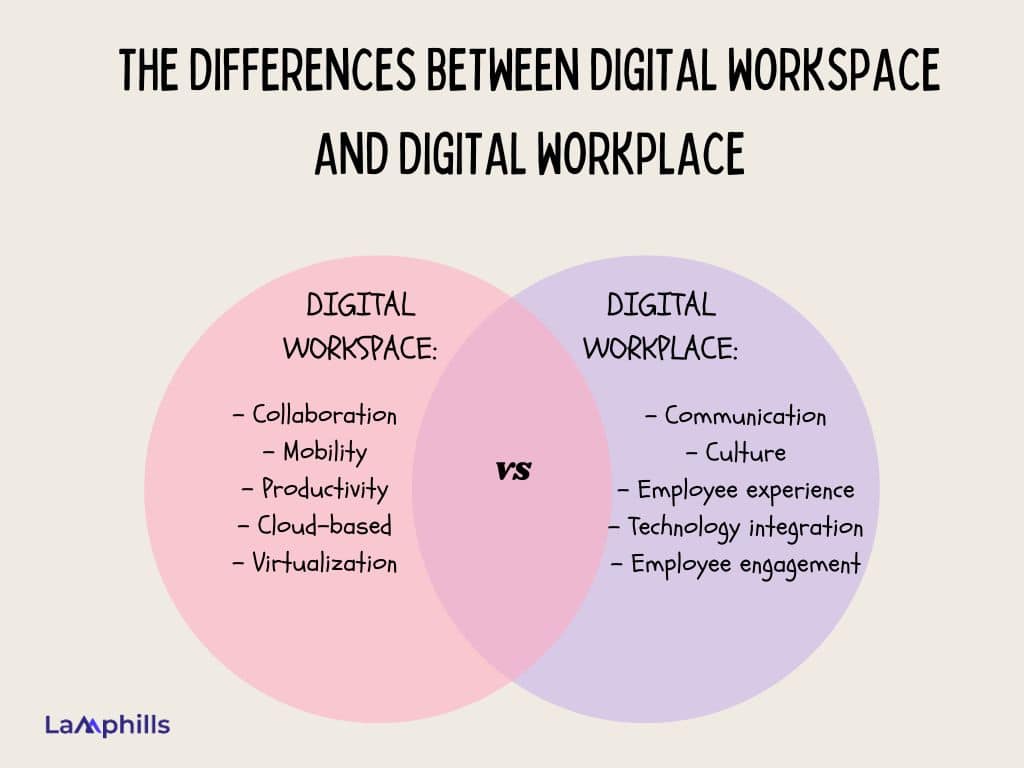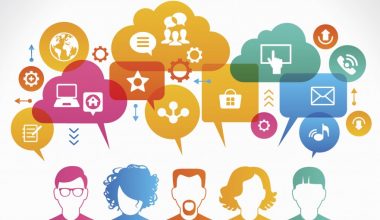As the famous saying goes, “All work and no play makes Jack a dull boy.” Indeed digital workspace has revolutionized the way we work and play in the modern era. Imagine a world where your office is not limited by physical boundaries, where you can seamlessly collaborate with colleagues from different parts of the world, and access your work from anywhere, at any time. Welcome to the era of the digital workspace. So, what exactly does a digital workspace entail, and what benefits does it offer? Read on as I explain what digital workspace entails, including the collaborative solution tools and benefits. Let’s dive in!
Key Points
- Digital workspace enables employees to work from anywhere at any time, leading to improved productivity and efficiency.
- With tools like project management software and communication platforms, team members can collaborate seamlessly, regardless of their physical location.
- This provides the flexibility for employees to choose when and where they work, promoting a better work-life balance.
- Organizations can achieve cost savings by reducing the need for physical office space and commuting expenses.
- Besides, with advanced security measures like encryption and multi-factor authentication, digital workspaces offer enhanced data protection against cyber threats.
What Is A Digital Workspace?
A digital workspace is a virtual platform where individuals can access and manage all the tools, applications, and data they need to work efficiently from any location and device. It provides a seamless and integrated environment that enables collaboration, communication, and productivity in a digital format.
Imagine you wake up in the morning, grab your cup of coffee, and sit down at your home office desk. As you log in to your digital workspace, you are instantly connected to your emails, calendar, project management tools, and virtual meetings platform. You receive notifications about the tasks for the day, updates from team members, and upcoming deadlines. With a few clicks, you can access shared documents, communicate with colleagues via chat or video conference, and collaborate on projects in real time. You like it, right?
Well, digital workspace serves as a centralized hub that brings together all the tools and resources needed for your workday. It eliminates the need to switch between multiple applications or devices, streamlining your workflow and increasing your efficiency.
As someone who is currently working remotely, I rely heavily on digital workspaces to stay connected and productive. My team uses platforms like Microsoft Teams and Google Workspace to collaborate on projects, share updates, and communicate effectively. These tools have streamlined our workflow and made it easier to coordinate tasks, even though we are not physically together.
Digital Workspace Solution
A digital workspace solution encompasses a set of tools and technologies that enable employees to access their work resources and collaborate seamlessly from any location and device.
One of the key advantages of a digital workspace solution is the flexibility it offers. With all the necessary tools and applications accessible through a centralized platform, I can work from anywhere, whether it’s from the office, home, or while traveling. This flexibility has greatly improved my work-life balance and allowed me to work more efficiently.
Additionally, the collaborative features of a digital workspace solution have transformed the way teams work together. Through features such as real-time messaging, video conferencing, and shared document storage, my team can communicate and collaborate effectively regardless of physical distance. This has not only improved our productivity but has also fostered a greater sense of camaraderie and teamwork.
Furthermore, the security measures integrated into a digital workspace solution give me peace of mind knowing that my work data is protected. Therefore, with features like multi-factor authentication, encryption, and data loss prevention, I can confidently work without worrying about potential security breaches.
Collaborative Digital Workspace
As we know, “a problem shared is a problem halved.” That’s exactly what a collaborative digital workspace entails. In my personal experience, working within a collaborative digital workspace has shown me the power of teamwork and shared knowledge. When team members come together to work on a project using digital tools, ideas are shared more easily, solutions are found more quickly, and tasks are accomplished with greater efficiency.
Just like how splitting a problem in half by sharing it with someone else can make it easier to solve, working in a collaborative digital workspace allows individuals to share the workload, leverage each other’s strengths, and ultimately achieve better results. By embracing this approach, individuals can harness the collective intelligence. Also, creativity of the team to overcome challenges and drive success in their projects. Meanwhile, download the document below to get collaborative digital workspace solution tools.
Collaborative Digital Workspace Solution Tools
What Is Digital Office Work?
Digital office work refers to the tasks and responsibilities carried out within a professional setting using digital technologies and tools. This includes using computers, software applications, email, and cloud services to perform job-related functions. That’s communication, data entry, document creation, collaboration, scheduling, and more.
As a professional, I can tell you that digital office work has become increasingly important in today’s business environment. It allows employees to work remotely, collaborate with colleagues from different locations, and access information quickly and efficiently.
In a nutshell, digital office work enables individuals to streamline their work processes, increase productivity, and stay connected in a digital world. Therefore, it’s like bringing the traditional office setting into the digital world to ensure smooth and efficient operations.
What Is The Concept Of Digital Workplace?
The concept of a digital workplace is all about blending technology, tools, and processes to create a modern and efficient work environment. Think of it as your traditional office space, but upgraded and optimized for the digital age.
Imagine having all your work resources – documents, communication tools, and applications – accessible from anywhere, at any time, using just your laptop or smartphone. That’s to say, no more physical desk or office space.
For example, my team uses tools like Slack for instant messaging, Google Drive for file sharing, and Zoom for virtual meetings. These digital solutions help us stay organized and productive, even when we’re not in the office together.
What Is The Difference Between Digital Workspace And Digital Workplace?
Isn’t it intriguing how the terms seem similar yet signify distinct concepts in modern work environments?
The digital workspace encompasses the technologies and tools individuals use to perform tasks and collaborate from any location, fostering flexibility and efficiency. On the other hand, the digital workplace extends beyond the tools to encompass the overall work environment. This includes the physical space, company culture, and processes that support digital transformation and enhance employee experience.
So, while the digital workspace focuses on tools and technologies, the digital workplace encompasses a broader spectrum of elements that shape the modern work environment.

What Is An Example Of A Digital Workspace?
An example of a digital workspace is Microsoft Teams. Microsoft Teams is a collaboration platform that allows for communication, file sharing, and collaboration among team members in real time. It provides a centralized location for team members to work together, whether they are in the same office or working remotely.
I use Microsoft Teams extensively in my work environment. Within my team, we have set up different channels for specific projects or topics. This helps to keep our conversations organized. In these channels, we can share files, have discussions, and even schedule meetings using the built-in calendar feature.
One of the key features of Microsoft Teams that I find particularly useful is the ability to integrate with other Microsoft applications, such as OneDrive and SharePoint. This seamless integration allows us to access and edit files directly within Teams, without having to switch between multiple platforms.
Additionally, Microsoft Teams offers a range of communication options. This includes direct messaging, group chats, video calls, and even the ability to make phone calls. This versatility has greatly improved our team’s ability to communicate effectively, especially as we are often working from different locations.
What Are The Benefits Of A Digital Workspace?
Of course, digital workspace offers lots of benefits and I’ll share some of them with you. One significant advantage is increased flexibility and remote access to work-related data and applications. With this workspace, I can seamlessly work from anywhere, whether it’s from the comfort of my home, a coffee shop, or while traveling. This flexibility not only enhances productivity but also improves work-life balance. That’s allowing me to better manage my time and priorities.
Moreover, a digital workspace fosters collaboration and communication among team members, regardless of their physical location. Through various digital tools and platforms, such as project management software and video conferencing, I can easily connect with colleagues, share ideas, and work together on projects in real-time. Hence, this level of connectivity not only enhances teamwork and innovation but also streamlines workflows and decision-making processes.
Overall, the benefits of a digital workspace are vast and undeniable for modern professionals seeking efficiency and agility in their work environment.
Challenges Of A Digital Workspace
While digital workspace offers lots of benefits, users may encounter some challenges. First, a digital workspace poses the issue of data security and privacy. As more work processes are moved online, there is a higher risk of sensitive information being compromised or accessed by unauthorized individuals. For example, if a company’s cloud storage system is not properly secured, there is a potential for crucial data to be stolen or leaked.
Another challenge is the potential for distractions and lack of focus in a digital workspace. With the constant influx of emails, messages, and notifications, employees may find it difficult to concentrate on their tasks and maintain productivity. For instance, platforms like social media or instant messaging can lead to employees getting sidetracked from their work responsibilities.
Furthermore, the lack of personal interaction and face-to-face communication can be a challenge in a digital workspace. Without physical interactions, misunderstandings can occur more easily, leading to miscommunication and a lack of cohesion within teams. For example, tone and intent can be misinterpreted in written messages or emails, causing unnecessary conflicts among team members.
Lastly, the rapid pace of technological advancements can be overwhelming for some users in a digital workspace. Keeping up with software updates, new tools, and platforms can be time-consuming and require constant learning and adaptation. For instance, if an organization adopts a new project management tool, employees may need to undergo training to effectively utilize the tool. Then, this can lead to a temporary decrease in productivity.
Wrapping Up
Having explained what Digital workspace entails, I find digital workspace beneficial as it allows me to work remotely, increasing my productivity and flexibility. It also promotes collaboration among team members by providing a centralized platform for communication and file sharing. Hence, I highly recommend embracing digital workspace to streamline your work processes for enhanced productivity and work-life balance.
Related Articles
Monitoring Online Content: How To Do This In 5 Steps
Corporate Communications: Strategies to Amplify Your Brand’s Message
Internal Communications for PR Success: Aligning Your Team and Keeping Everyone on Message






